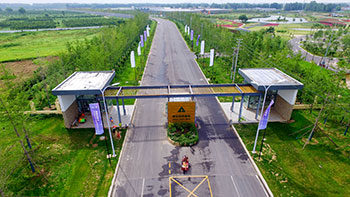During the full construction cycle, the Group aims to minimize the use of resources (energy, land, water, and materials) in hopes to protect the environment and reduce pollution. This is to provide a healthy, appropriate, and efficient functional space and a natural and harmonious architecture.
Green Architecture must first follow the principle of ecology, i.e. saving energy, harm-free, pollution-free, and recyclable;
The Principle believes that Green Architecture should not lower people’s quality of life, forgo health and comfort, nor utilize unnecessary energy-saving technology. Since the start of the project design, Green Architecture has included green design to accommodate customers’ living style and their need for energy-conservation;
The practice of Green Architecture needs to take into consideration of the land’s properties, local resources, and level of urbanization etc.
Green Architecture emphasizes all-rounded design ideology, combining various factors such as weather, culture, and economy to an integrated analysis. The Principle does not replicate the so-called “Advanced Ecological Technology” blindly, nor neglect the overall picture over partial details. For instance, it makes little sense to use insulating materials in tropical region, whereas insulating materials would help little in energy conservation in cold regions with underwhelming thermal properties for the windows in use. The overall design has a direct impact on the utility and cost of Green Architecture.
Green Buildings
By 31 December 2021, CCRE had 62 green building projects with GFA of 9.92 million sq.m. that met with Henan Province Evaluation Standard for Green Building.
The prefabricated buildings utilization rate exceeded 50% for some of the Group’s projects in Hainan province, and Xinxiang City and Luoyang City in Henan province, which was above the government’s requirement that calls for prefabricated buildings to account for no less than 30% of newly constructed buildings. Starting with the entire green building life cycle, CCRE explored ways to save energy and reduce consumption, and we continuously upgraded our processes to save energy and reduce emissions throughout the real estate development life cycle.
Green Houses
As of 31 December 2021, the Group had 4 operating green houses: Yanling Green House, Yichuan Green House, Hebi Green House and Zhoukou Green House, with a total area of 22,705 Chinese mu. Based on the model of “modern agricultural industrial parks + traditional residences and folk customs + nature education + unique cuisine”, the Group has built new types of agriculture highlighting “efficient agriculture, agri-tourism, cultural creative agriculture, experience centre agriculture, science popularisation agriculture and health and old-age care agriculture”. The Group has explored new ways to upgrade the agricultural industry and help farmers to find jobs and increase income so as to revitalise the rural area.

CCRE established a green finance framework in December 2020 and received Second-Party Opinion from Sustainalytics, an independent third-party rating agency. The Green Finance Framework has been developed to detail how CCRE and its entities intend to issue Green financing transactions to fund projects and developments that will deliver environmental benefits to support CCRE’s business strategy and green and sustainability vision。
CCRE – Green Finance Framework December 2020
CCRE – Green Finance Framework Second-Party Opinion December 2020
